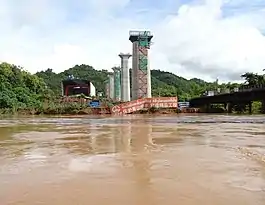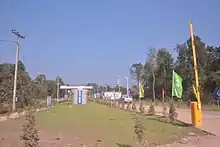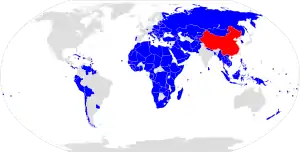Boten–Vientiane railway
The Boten–Vientiane railway (often referred to as the China–Laos railway) is a 414 kilometres (257 mi) 1,435 mm (4 ft 8 1⁄2 in) standard gauge electrified railway under construction in Laos, between the capital Vientiane and the small town of Boten on the border with China.
| China–Laos railway | |
|---|---|
 Bridge construction near Luang Prabang. | |
| Overview | |
| Status | Under construction |
| Owner | Laos-China Railway Co., Ltd. |
| Locale | Laos |
| Service | |
| Operator(s) | Laos-China Railway Co., Ltd. |
| History | |
| Commenced | December 2016[1] |
| Planned opening | December 2021[2] |
| Technical | |
| Line length | 414[3] km (257 mi) |
| Number of tracks | 1 |
| Track gauge | 1,435 mm (4 ft 8 1⁄2 in) standard gauge |
| Electrification | Overhead line |
| Operating speed | 160 km/h (passengers) 120 km/h (cargo)[1] |
Boten–Vientiane railway | ||||||||||||||||||||||||||||||||||||||||||||||||||||||||||||||||||||||||||||||||||||||||||||||||||||||||||||||||||||||||||||||||||||||||||||||||||||||||||||||||||||||||||||||||||||||
|---|---|---|---|---|---|---|---|---|---|---|---|---|---|---|---|---|---|---|---|---|---|---|---|---|---|---|---|---|---|---|---|---|---|---|---|---|---|---|---|---|---|---|---|---|---|---|---|---|---|---|---|---|---|---|---|---|---|---|---|---|---|---|---|---|---|---|---|---|---|---|---|---|---|---|---|---|---|---|---|---|---|---|---|---|---|---|---|---|---|---|---|---|---|---|---|---|---|---|---|---|---|---|---|---|---|---|---|---|---|---|---|---|---|---|---|---|---|---|---|---|---|---|---|---|---|---|---|---|---|---|---|---|---|---|---|---|---|---|---|---|---|---|---|---|---|---|---|---|---|---|---|---|---|---|---|---|---|---|---|---|---|---|---|---|---|---|---|---|---|---|---|---|---|---|---|---|---|---|---|---|---|---|
| ||||||||||||||||||||||||||||||||||||||||||||||||||||||||||||||||||||||||||||||||||||||||||||||||||||||||||||||||||||||||||||||||||||||||||||||||||||||||||||||||||||||||||||||||||||||
In the north the line will be connected to the Chinese rail system in Mohan, through the Yuxi–Mohan railway. In the south it meets the existing metre-gauge railway in Thanaleng, linking it via Nhong Khai in Thailand to Bangkok. A high-speed, standard gauge extension to Bangkok is also under construction. When finished, the Boten–Vientiane railway will form an important part of the Kunming–Singapore railway.
China aims to build a 5,500-km trans-Asia railway, which begins in Yunnan's provincial capital Kunming and travels through Laos, Myanmar, Thailand, Vietnam, Cambodia and Malaysia, before ending in Singapore, according to Ding He, a deputy project manager for the China–Laos railway project.[4] The Boten–Vientiane railway is part of the Belt and Road Initiative.[5][6]
Background
Laos is the only landlocked country in Southeast Asia, which hinders trade of goods. During the French rule, the French failed to materialize a possible plan to build a railway in Laos, with only the 7 km Don Det–Don Khon railway being completed.[7] A railway link through Laos would greatly reduce cargo transit times and transportation costs between Laos and China. The railway would also be a link in the Kunming–Singapore railway network, as well as a program within the One Belt One Road Initiative.
The railway is also expected to boost tourism, with passenger traffic to account for the majority of traffic on the line.[6][8]
History
The first talks about the railway linking Laos and China were in 2001, Laotian and Chinese politicians both confirmed the plans in 2009. Somsavat Lengsavad was reportedly the driving force behind the project on the Laotian side.[5] After the corruption scandal of China's minister of railways Liu Zhijun, the start of construction was delayed until early 2016.[9]
Construction began at Luang Prabang on December 25, 2016.[10] At the end of 2017, the construction phase was 20% completed,[11] and in September 2019 progress was reported as 80% completed.[12] Unexploded bombs that have been dropped during the Vietnam War will also be removed along the route.[13]
As of June 2020, Chinese state media reported that the US$6 billion project was 90% done. Work crews started laying track in Laos in March 2020, five years after breaking ground. With all of the many dozen tunnels and bridges completed, service is set to start in December 2021.[14]
Financing
The cost of the project is estimated at 6 billion US dollars. Lao government borrows 60% (3.6 billion US$) from the Export-Import Bank of China and the remaining 40% (2.4 billion US$) is funded by a joint venture company between the two countries. China holds 70% of the stake of the company. Of the rest of the stake, Lao government disburses 250 million US$ from its national budget and borrows 480 million US$ further from the Export-Import Bank of China. [9] [15]
Debt trap concern
There is a global concern that the railway project, along with others, could make Laos fall into China's debt trap. [16] [15] [17]
In 2019, Lowy Institute estimated Laos' debt to China at 45 percent of its GDP. [16] In 2020, Fitch Ratings assigned Laos a 'CCC' credit rating, mentioning its excessive debt amount. [18]
Infrastructure

Forty-seven percent of the railway will be in 75 tunnels and 15% will pass over viaducts spread over 167 bridges.[9] There are 32 planned stations along the route.[10] The final station would be Thanaleng station, not Vientiane Station. Xay Village in Xaythany District is to be the site of Vientiane Station, the largest station on the railway. The station will consist of four platforms with seven track lines and two additional platforms with three lines reserved. It is expected to connect with other railway lines planned for Laos. The station will accommodate up to 2,500 passengers with a total area of 14,543 square meters.[19]
The railway is to be built to China's GB Grade 1 standard (suitable for 160 km/h passenger and 120 km/h freight trains), making Laos the first country to connect to the Chinese railway network using Chinese technology.[8]
A new bridge will be constructed by 2023 from Thanaleng to Nong Khai to connect the high speed rail network into Thailand.
See also
 Rail transport in Laos
Rail transport in Laos Vientiane–Vang Vieng Expressway
Vientiane–Vang Vieng Expressway Railway stations in Laos
Railway stations in Laos Railway stations in South East Asia
Railway stations in South East Asia
References
- "Laos-China railway brings changes to Laos". China Daily. 7 August 2017.
- "China's rail network opens up transport links in Laos". The Star. 20 Jan 2020.
- "China–Laos railway project set to be complete by late 2021". People's Daily. 20 November 2017.
- "China–Laos railway achieves tech breakthrough". China Daily. 30 April 2019.
- "Land-locked Laos on track for controversial China rail link". Nikkei Asia. Retrieved 2020-11-05.
- "Transforming Lao PDR from a Land-locked to a Land-linked Economy". World Bank. Retrieved 2020-11-05.
- Freeman, Nick (2019-12-11). "Laos' high-speed railway coming round the bend". ThinkChina - Big reads, Opinion & Columns on China. Retrieved 2020-11-05.
- Brian King. "Chinese railway could put Laos on the tourist map". CNN. Retrieved 2020-11-05.
- "Land-locked Laos on track for controversial China rail link". Nikkei Asian Review. 24 June 2017.
- "Everything You Need to Know About the Laos–China Railway". The Laotian Times. 20 February 2017. Retrieved 2018-12-20.
- "Laos–China railway '20.3 per cent complete', compensation still unpaid". The Nation. 7 February 2018. Archived from the original on 2019-06-12.
- "Nearly 80 pct of China–Laos railway construction completed". Xinhua News Agency. 22 September 2019. Retrieved 2020-01-31.
- "Unexploded ordnance to be cleaned along Laos–China railway". China Internet Information Center.
- http://www.xinhuanet.com/english/2020-09/29/c_139406173.htm
- "Can Laos profit from China rail link despite being US$1.5 billion in debt?". South China Morning Post. 10 December 2019.
- "Laos Stumbles Under Rising Chinese Debt Burden". The Diplomat. 7 September 2020.
- "Taking power - Chinese firm to run Laos electric grid amid default warnings". Reuters. 4 September 2020.
- "China's debt-trap diplomacy: Laos' credit rating downgraded to CCC". Thailand Business News. 2 November 2020.
- Phonevilay, Latsamy (4 July 2020). "Construction of Vientiane Station Commences on Laos–China Railway". The Laotian Times. Retrieved 6 July 2020.
External links
- Laos–China Railway Co., Ltd. – a joint venture between Laos and China to build and operate the railway.
- Boten–Vientiane railway on OpenStreetMap
- Boten–Vientiane railway on Google Maps
- Full construction details superimposed on a satellite map by Design for Conservation
